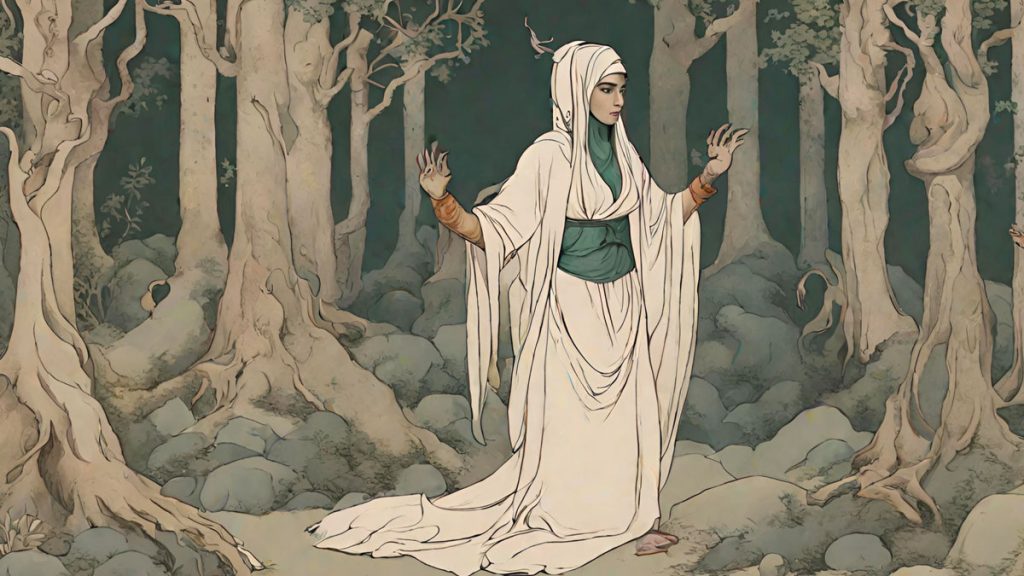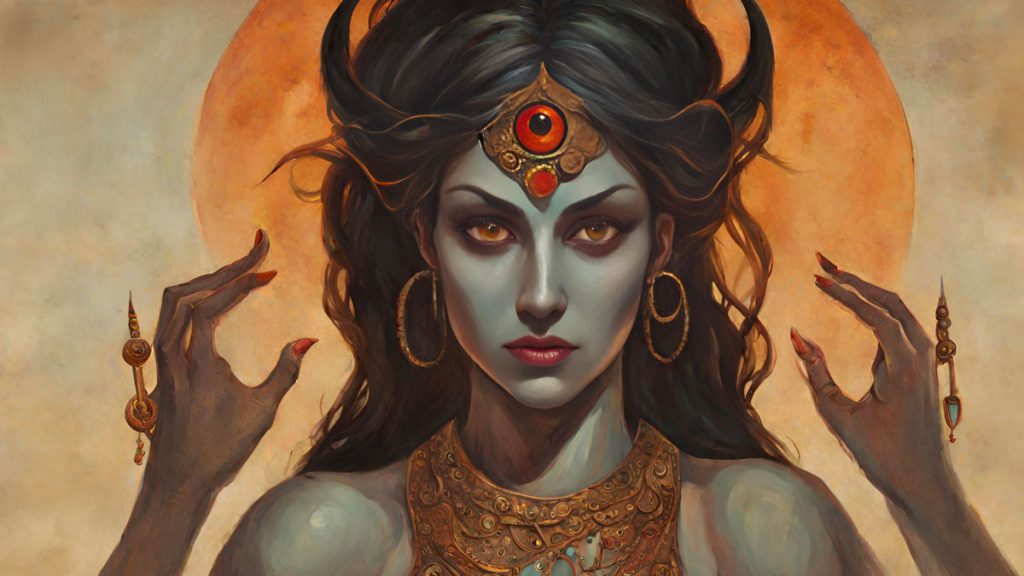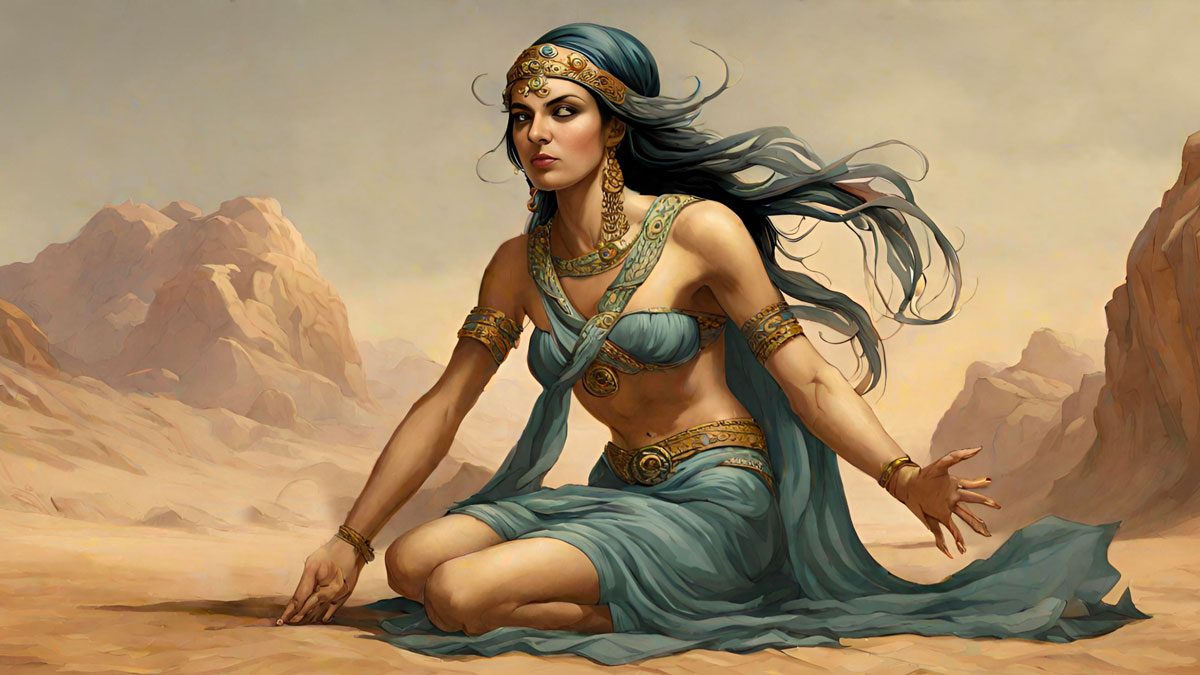A sílā, sometimes spelled si’la or si’lat, is a spiritual being prevalent within Islam and Arabic folklore. It is female and is mainly known for using magical powers to entice or trick men. It is considered to be similar to a witch from Western cultures. It is a type of jinn.
Just like the other jinns, sílā, according to the Quran and other Islamic teachings, is a creature classed somewhere between an angel and a human. God created them using fire, which differs from humans, who were made using soil. The sílā are considered to be one of the most malicious and evil types of jinn.
The sílā, along with the other jinns, were created by God as one of three intelligent species, and just like the angels and humans, they were created with free will.
The Sílā are witchlike beings who seduce human men
Sílās are witchlike shapeshifters who take female human form. The sources often describe them as being hideous hags but will similarly refer to them as appearing particularly attractive or seductive to men. This is likely because they are skilled shapeshifters who have become adept at fooling humans, particularly men. They are usually unseen by people who are not their direct targets.
The goal of the sílā isn’t necessarily evil but mainly to attract human men for mating. Some sílā may actually form a close bond with their human mate.
The result of a sexual encounter between a human and sílā is a hybrid baby known as a Banu Si’lat. The legend of the Banu Si’lat goes back to before the pre-Islamic era and has endured throughout the centuries.
The legend, as told by Abu Zaid, states that a man married a si’lat, and the pair had multiple hybrid children and, by all accounts, lived very happily until one day, the sílā saw a flash of lightning coming from above her tribal lands. She saw this as a sign that she must return to her own tribe, and she left, never to be seen again. One rumor emerged that all Arabs are descended from half-si’lat children.
The Sílā differs from a Ghoul
Sometimes, a sílā will kill her human partner after sexual relations. In this way, they are very similar to a ghoul (ghūl). A ghoul is a particularly wicked type of Jinn that lives in the desert and will often take the form of a human female to seduce and murder humans before devouring them.
A sílā differs from a ghoul because they are actually female and do not just assume female form. Unlike a ghoul, the sílā is tempting human men not purely for malicious reasons but because she wants a mate. The sílā may kill the man after sexual relations, but they might allow them to go free or live with them in a traditional relationship.
Some sources even suggest that sílā differs further from ghouls because they cannot shapeshift at all, but opinion is divided here. A final contrast with ghouls contends with living space; ghouls almost exclusively inhabit desert areas, whereas the sílā are often found in woodland areas or anywhere that is isolated.

But both ghouls and sílā will live in isolated places where they can interact with lonely travelers away from the prying eyes of others.
Opinions divided on the Sílā traits
Arabic sorcerers have reportedly used sílā to curse an individual, using the creatures to exact a kind of torture on their poor victims. The sílā are often unwilling participants in this sorcerer’s curse.
Other resources dispute that the sílā’s only goal is to procreate, claiming they often go out of their way to meddle in the affairs of humans, and perhaps surprisingly, this is usually in a helpful way.
The nomadic Arabic tribes of the Bedouin accused sílās of chasing their camels away from grazing land. In these folklore tales, the sílā are rarely seen by human eyes.
Mostly, the creatures are portrayed as annoying tricksters at best and vicious killers at worst.
The best line of defense against a sílā is simple awareness. When encountering a strange, seductive woman-like being in isolated areas, be on the lookout for hooves, claws, demon eyes, or other animal-like characteristics. Another act of defense could be prayer and following the teachings of the Quran and other Islamic texts.

According to 19th-century Iraqi historian Mahmud Shukri al-Alusi, the term si’lat was often used as a derogatory term to describe women who were unfaithful or just considered slim, witty, and powerful.
Similar demons to the Sílā in other non-Arab legends
The sílā is perhaps related to the succubus, a similar female demon-like creature that is better known in Western cultures. The succubus ensnares men for sexual relations, and just like the sílā, can be good or evil.
The sílā and the succubus share the same trait that early descriptions portray them as ugly, hag-like demons, but later iterations of the legend describe beautiful, seductive women.
The succubus myth perhaps originates back to early Jewish religious texts, which state that God created Lilith as a companion for Adam, but she insisted on being treated equally to him and refused to lie under him during sex. Lilith was thought to be the first succubus, and that she gave birth to hundreds or thousands of similar demons.
However, similar creatures to the sílā or the succubus are seen throughout numerous cultures and geographic regions. They appear in ancient Greek mythology, where they likely evolved into the Sirens, who lure sailors to their deaths with their enchanting singing.
Female demons and amorous fairies also appear in Celtic myths. Some sources say the wizard Merlin was the son of an incubus, which is the male version of a succubus.
Another similar creature to the sílā is the churel; originating from India and Pakistan, the churel is a vengeful female spirit who returns to earth following death to drain the blood, life, or semen of their male victims.
Another interesting source for the possible emergence of sílā, and of jinn as a whole, is that of the Mongolian warriors who swept toward Arab lands in the Middle Ages. The skill and expertise of these horseback riders warriors may have appeared inhuman.
References
Amy Sumida, “The Jinn: A Mystical Race,” accessed March 7, 2024.
Cryptidz.com, “Si’lat,” accessed March 7, 2024.
Cyodine.com “History of the Succubus,” accessed March 7, 2024.
Fairytales & Myths, “Ghoul,” accessed March 7, 2024.
Hoelder, A. “Wiener Zeitschrift für die Kunde des Morgenlandes,” (Viennese Journal for the Customer of the Orient), 1894, https://tinyurl.com/wt9u635t, accessed March 7, 2024.
InTheDark.com, “Malicious Myths: The Churel,” accessed March 7, 2024.
Mysticmagicks.com, “Si’lat (Sila) Djinn,” accessed March 7, 2024.
VocalMediaJournal.com, “Exploring the 10 Types of Jinn as Described in Islamic Belief,” accessed March 7, 2024.
